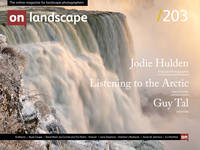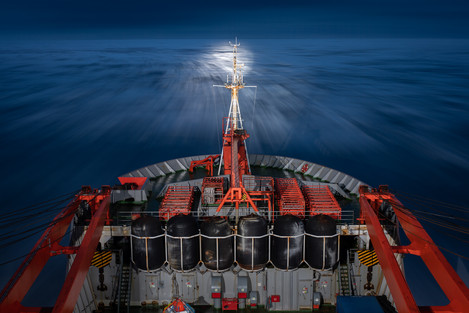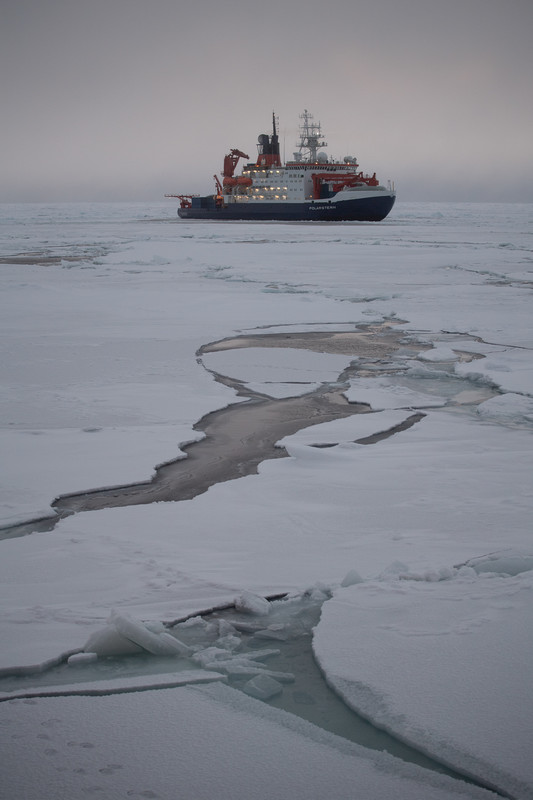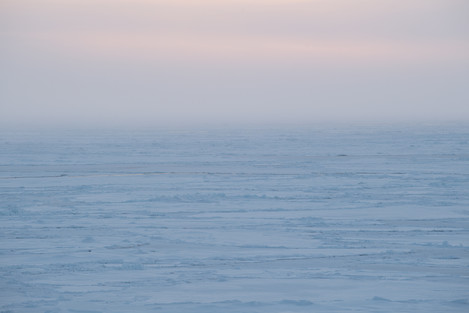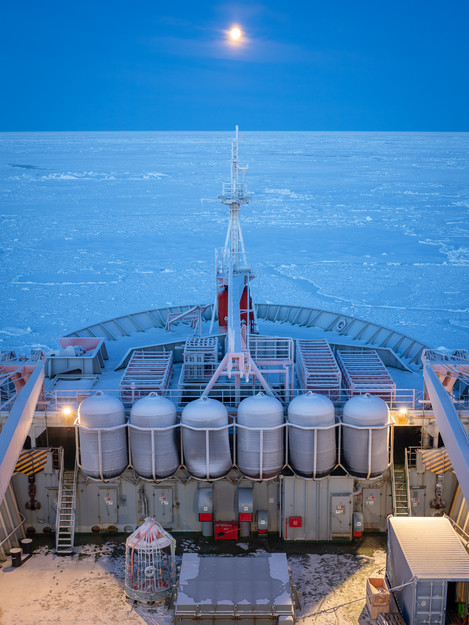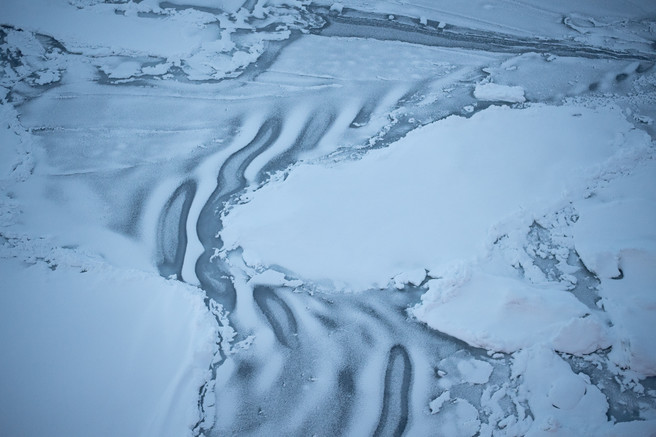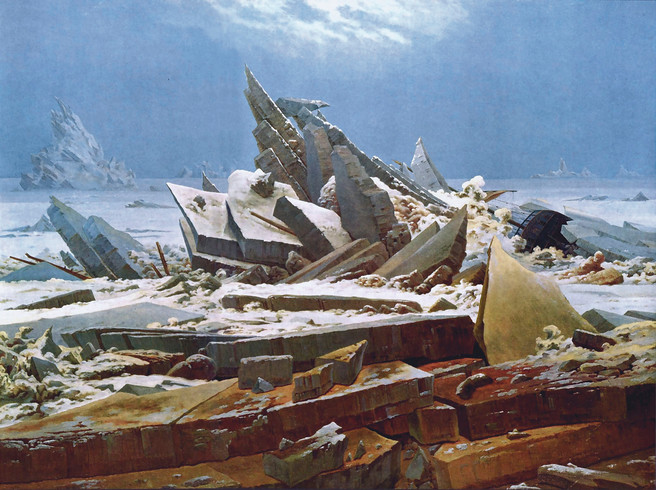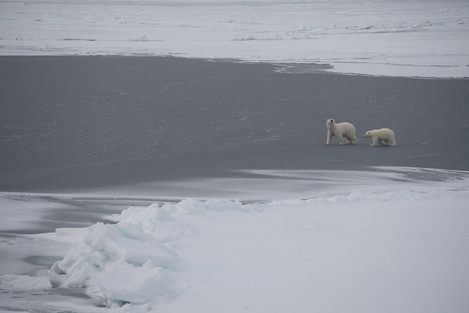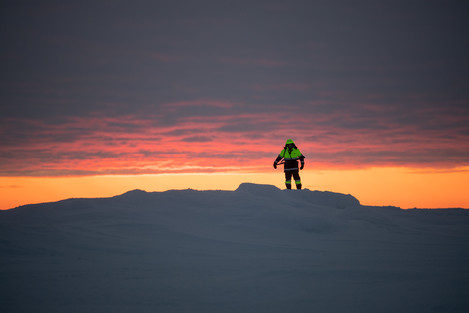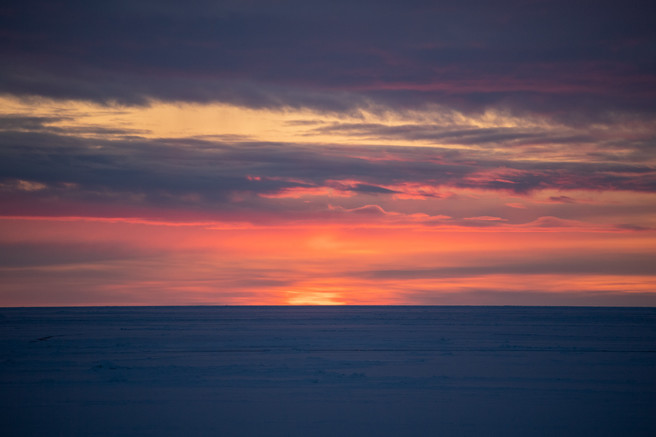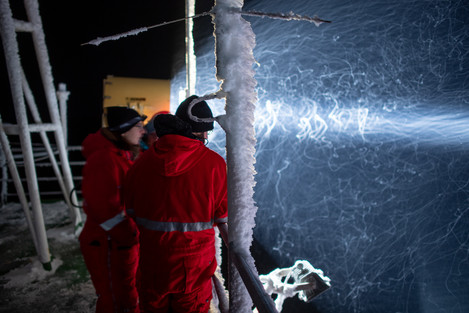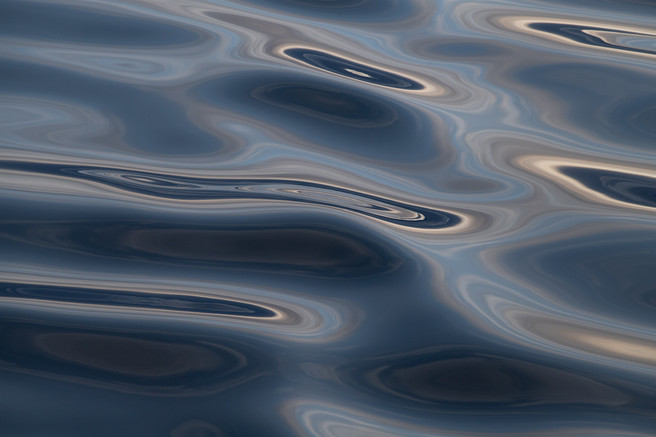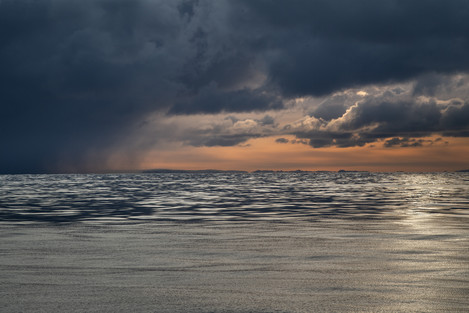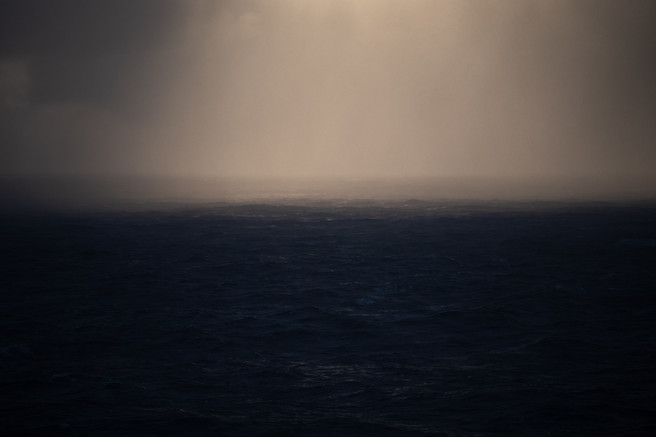A unique landscape is being lost from the face of the Earth

Sam Cornish
Sam Cornish is a PhD student in physical oceanography at the University of Oxford, and is funded by a Natural Environment Research Council studentship. His research focuses on the Arctic Ocean, and the physical connections between winds, sea ice, and ocean dynamics. As part of the MOSAiC school, Sam has been making short podcasts about the MOSAiC expedition using interviews he recorded onboard. These can be found at Buzzsprout and played on your podcast player of choice. His research profile and publications can be found on the link below.
The Arctic is warming twice as fast as the rest of the world. In concert, its landscape is changing irrevocably. This landscape of ice is dynamic, an attribute that means the Arctic is probably the hardest place in the world to make observations of the climate system. Yet it is this dynamism that makes this landscape so fascinating—for scientists, photographers, storytellers and consumers of stories and art alike. The changes in the Arctic demand the attention of climate scientists like never before, but they can also speak to all of us, and we should listen.
Why is it so difficult to observe the Arctic? For much of the year, the Arctic Ocean is covered in a pack of sea ice, made up of millions of individual ice floes that shear, break apart and buckle, propelled by winds and currents in almost perpetual, destructive motion. Nothing can be considered permanent atop the ice. The ocean beneath it, meanwhile, is cast in a satellite communications shadow—the autonomous underwater floats and gliders that have revolutionised global oceanography cannot work there.
The best way to make observations in the Arctic is to be passive, to drift with the dynamic frozen ocean. The German Icebreaker Polarstern has been doing exactly that since the start of October 2019. Polarstern is the fulcrum of the MOSAiC expedition, the Multidisciplinary drifting Observatory for the Study of Arctic Climate. The expedition is bringing together scientists who study the ocean, the atmosphere, sea ice, ecosystems and biogeochemistry, to deliver the most comprehensive dataset yet of the Arctic climate system. I was lucky enough to be involved in the first leg of the MOSAiC expedition as one of 20 postgraduate students on the MOSAiC School, based on partner research vessel Akademik Fedorov.
The MOSAiC comms team draws frequent links to Nansen’s Fram expedition. And these links are apposite: the Polarstern will follow a similar path to the Fram, and the comparison recognises Nansen’s own contributions to Arctic science. But there will also be stark differences. The ice is thinner and much more mobile now; Polarstern’s ice-bound journey across the Arctic will take just one year — the Fram took three.
Working in cold conditions, you do your best to prepare the instruments for their future. We would struggle with motors that wouldn’t start and fingers that lost their dexterity. But it is after deployment that the instruments face their biggest challenges. They can be consumed by convergent ice in a pressure ridge, or topple into a newly opened crack in the ice—a lead. They can become an object of curiosity for a polar bear. Or, if their GPS fails, their position might become untraceable, especially if deployed by helicopter at a distance from the ship. Arctic pack ice can drift 10 kilometres in a day, and you might never find that bit of silver machinery in a sea of white to fix it.
At the central floe, the first big winter storm sheared part of the floe in two. The scientists onboard Polarstern had to battle the elements to recover instrumentation and reassemble one of their observational ‘cities’. These cities, populated by finely-tuned instruments, are vulnerable to icequakes.
It is this dynamism of the ice which shapes the landscape. On the Fedorov, we could climb to the very top of the ship, where every surface was covered with ice as thin as the wings of a fly and arranged into big triangular sails and bristling Christmas trees. It really felt like Coleridge’s secret ministry of frost, coating the spires of satellite towers. From there, we could look out over the sea ice.
In the early winter, it is a wind-scoured plain, with interlocking plates of ice creating an uneven patchwork of grey and white, occasionally cut by thin slivers of light where leads lie. At the margins of these plates, the ice is deformed, low jumbled walls of ice are constructed. Those that are remnant from the previous winter are softened by wind and snow, with long fluted snowdrifts, or sastrugi lying in their wake. At most a year old, these ridges look like ancient remains. In the subdued light that often characterises polar twilight, a band of colour on the horizon resides between two oceans of white and grey. Towards the sun, the band is pink and orange, and the ice beneath looks dark. Turn 180 degrees, and the band in the sky is a deep milky blue; the ice beneath it glows. In between these poles, there is a zone where sky and ice are matched in lightness.
The dynamism of sea ice also gives it a special place in the human imagination, because of what it can do to us. As dwellers of lower latitudes, our vision of this environment is shaped by the stories that the whalers and explorers of the 18th and 19th centuries brought back—or the stories we infer from their remains. Stories of becoming helplessly trapped in the ice, listening awake at night to the desperate straining of timbers against converging ice. The terror of the mortal grip of sea ice was rich subject matter for artists of the sublime. Caspar David Friedrich’s 1824 painting The Sea of Ice was entirely a creative vision; he only had accounts of polar exploration and the ice on the surface of the river Elbe, near Dresden, as subject matter. But the work communicates the devastating power of sea ice and gives us an insight into how this environment crystallised in the collective imagination.
Carving through sea ice on the Fedorov, the sound of scraping became background noise.
In Arctic Dreams (1986), Barry Lopez writes that modern venturers through the ice do not sleep ‘free of the stories that have been passed down’. Lopez reminds us that ‘the frozen ocean itself still turns in its winter sleep like a dragon’. And it will continue to turn, its sleep more restless than ever, as the ice is more mobile. But it is less impassable now, and curiously, it is younger, too.
The decline of Arctic sea ice with climate change is most pronounced in summer. The summer sea ice extent has reduced by 50% during the satellite era (since the late 1970s), and its average thickness is also down by approximately 50%. Its age, too, has decreased dramatically as less and less ice survives the summer months before being carried out of the Arctic Ocean or melting in situ. Ice more than four years old used to dominate the central Arctic; it now constitutes about one percent of the sea ice area. Nan Shepherd noted in The Living Mountain how hot summers in 1932-1934 put paid to year-round snow in the Cairngorms: ‘Antiquity has gone from our snow.’ And so it is for sea ice. This decline in age is also integrally linked with the appearance and character of the landscape. To understand this, we need to consider the growth phases of sea ice right from genesis.
MOSAiC was launched at the very start of the freeze-up season so that there would still be enough light to assemble instrumentation and to maximise the observational coverage of the winter. The timing also gave us the opportunity—and light—to see new ice grow. Sea ice begins life as individual crystals of frazil ice, which coalesce into thin films and soups of grease ice. In the lightly rippled open water between ice floes, you might see these early stages of growth by looking for the absence of ripples. In as little as several hours, grease ice can thicken into a dark elastic layer of nilas ice. As the Fedorov moved through leads with a new covering of nilas, we would spend minutes at a time watching the bow wave emanate away in gentle, tubular waves under the nilas. Squashed between two converging floes, nilas can bend into ripples. Windblown snow picks these ripples out, creating soft stripes that run parallel and coalesce. Nilas can then thicken and become grey ice, which can be thick enough for polar bears to walk on. As the ice continues to grow it gets whiter, and progressively rejects more and more salt from its crystal structure, become harder and more brittle.
Converging layers of nilas interfinger with surprising geometric regularity, tracing the outline of castle ramparts in the horizontal plane. Later in the life stages of ice, this same convergence causes great upheavals and the formation of real, vertical ramparts. Sea ice that has survived at least two summers is called multi-year or old sea ice and can be fresh enough to drink, thicker than three metres, and increasingly hard. The reduction in brine content means it has different electromagnetic properties to first and second-year ice and can be distinguished from space. On the ice too, the difference is more pronounced than the rather prosaic modifiers multi-year or old would suggest.
Working on residual ice (sea ice that has survived one summer*) the horizon is generally distant. From a human perspective, then, old ice is another landscape altogether. The horizon is as far as the nearest pressure ridge, which might loom over you by several metres.
Sea ice may never be as vertically impressive as the great architecture of freshwater ice. Ice sheets and glaciers are built from hundreds of thousands of years of snowfall, the air slowly squeezed out or trapped in bubbles. Where they meet the sea, they calve, releasing this crystallised history of snowfall into the ocean as icebergs. By contrast, sea ice is made in haste, under the freedom of the wind rather than the crushing weight of snow. And our oldest, most architecturally rich sea ice is departing in haste, too. Icebergs will continue to cascade into the high latitude oceans as ice sheets calve. But multi-year sea ice is on the ropes. It is now little more than a tenth of sea ice area and only survives where it is swept by winds against the North American continent. Nor does it exist in any significant measure in the Southern Ocean, where winds blow ice away from the polar continent, and heat fluxes from the ocean are greater. This old terrain of sea ice is soon to be consigned to that part of the imagination where the unreal resides.
It was polar night when we headed south from 85 degrees north to leave the ice behind. Around midday, on the 20th October 2019, we got the first real vivid colour on the horizon. That evening we came through the marginal ice zone and gathered excitedly to see pancake ice, c. 50 cm discs of thin ice, colliding against one another under wind and swell. It was a black and white leopard skin sea in the dark. Two days later in open water, amidst a three metre swell that opened and closed the drawers in our rooms, and made the sink pipes gurgle, we finally saw the sun again. It was a joyful return, and people hugged on the deck and smiled into the light.
There was also a certain sadness, too. We started to think about how in a decade’s time we might be able to sail through open water to the North Pole. How in the future, as Arctic scientists, we might be leading expeditions in an ocean essentially devoid of ice in the summer. How different it would be. How different it already was.
The loss of sea ice has significant implications for the climate system; within the Arctic and beyond it. The ice-albedo feedback is one well-known example. The replacement of reflective ice with darker ocean leads to more solar radiation being absorbed, and more warming at the Earth’s surface. It is often championed as the main reason for enhanced warming in the Arctic or Arctic Amplification, but the full picture is more complex. Arctic amplification is most intense in the winter when there is little or no solar radiation reaching the surface.
Likely more dominant is the lapse-rate feedback: the stable inversion layer** that characterises the winter Arctic atmosphere acts as an envelope for warming near the surface. This bottom-intensified warming is not compensated for by greater space-bound radiation higher up, where little or no warming has occurred, so the surface warming becomes intensified.
The influence of the rapid changes in the Arctic are spilling out of the high latitudes; by changing the Earth’s energy balance and temperature gradient from equator to pole, the Earth’s atmospheric circulation can be altered. The jet stream is powered by this temperature gradient, and the loss of sea ice appears to be connected to the propensity for wobbles in the jet stream to pause, prolonging extreme weather events at mid-latitudes.
The Arctic Ocean is also changing dramatically. Declining sea ice has gone in tandem with a more energetic circulation in the Beaufort Gyre, a wind-driven circulation north of Alaska that stores a vast quantity of cold and fresh seawater. A persistent shift in the winds could flush much of this recently accumulated freshwater into the subpolar North Atlantic, with potential implications for the large-scale ocean circulation of the Atlantic and midlatitude weather. Scientists across the world are working, through MOSAiC and through other initiatives, to better understand our climate, piece by interconnected piece.
As landscape photographers, we should sit up and take note that a unique landscape is literally being lost from the face of the Earth in the Arctic. We cannot replant it, we did not exploit it for resources; its loss is due to the integration of all greenhouse gas emissions and land use changes through recent history and across the world. As people who care about the landscape, we should mourn this loss. But we will have much, much more to mourn if we do not listen to the warning that its loss represents. We can all listen to the Arctic, and treasure the natural world in our actions as well as our imaginations.
*after Jan 1st it becomes known as second-year ice
** inversion layers are characterised by an atmospheric temperature profile that goes from cold at the surface to warmer higher up
- RV Akademik Fedorov enters the ice
- Polarstern, before she tethered to the central floe
- Deployment of instruments on the ice
- Perspective over the ice
- Full moon over the frozen ocean
- Ripples in nilas, pinched between blocks of older ice
- The Sea of Ice
- Polar bears walk on grey ice
- A polar bear guard stands atop a pressure ridge in residual ice
- The sun approaches the horizon
- Scientists gather to look at pancake ice in the marginal ice zone
- Rings of light, Barents Sea
- Stormy weather, Barents Sea
- A sea of change

